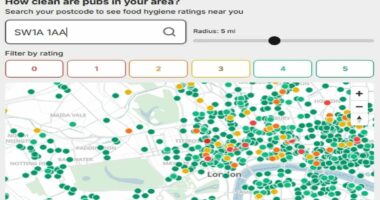Share this @internewscast.com

Drug-related fatalities in England and Wales have surged to unprecedented levels, with specialists forecasting a continued rise due to the alarming spread of a potent substance reportedly 300 times stronger than heroin.
In 2024, an unprecedented 5,565 deaths were attributed to drug poisoning, marking a distressing rate of 93.9 deaths per million, as revealed by the latest data from the Office for National Statistics (ONS).
Particularly concerning is the involvement of nitazenes, a highly potent synthetic opioid, in 195 of these fatalities. This figure is nearly four times the 52 deaths reported in 2023.
The ONS data encompasses a range of incidents, including drug misuse, dependency, accidental deaths, suicides, and complications from both illegal substances and prescription or over-the-counter medications.
Moreover, the agency noted that figures regarding drug misuse and specific substances are likely underreported. In about 20% of cases, the specific drugs involved are not detailed on the death certificate.
The statistics also highlighted a geographic disparity, with the North East of England and Wales continuing to exhibit the highest rates of drug poisoning deaths.
It is three times higher than the lowest region, the East of England.
There has also been a considerable rise in drug deaths in London, increasing to 662 from 500, experts say can be attributed to the cost of living crisis and rising levels of deprivation in the capital.
In the North West there were 873 deaths from drug misuse and drug poisoning, with nearly 300 in Manchester alone.
Ian Hamilton, associate professor of addiction at the University of York, told the Daily Mail: ‘A rise in deaths from nitazines, is a reflection of wider use, and this is a real concern.
‘There is also a delay in reporting these figures, so there is likely already wider use than people realise. This is just the start of a trend of rising nitazene deaths. It will undoubtedly rise next year and be with us as a problem for a while.’
The fear is that the drug is being cut into commonly used drugs without people realising and it could lead to a crisis like in the US where fentanyl, a similar drug, has taken hold.
The opioid fentanyl is 50 times stronger than heroin and is the primary drug in North America, where synthetic opioids are estimated to have caused 75,000 deaths in the US last year.
Nitazenes have similar properties to fentanyl, but can be up to 300 times stronger than heroin.
They were first detected in the UK from a sample of white powder found in the back of a taxi in Wakefield in April 2021, nitazenes have since been found in heroin, cannabis, cocaine, in a vape and most prevalently in black market pills sold as the anti-anxiety drug diazepam.
Mr Hamilton said: ‘This is a cheap and incredibly potent drug, so it is unsurprising that it is being used to bulk up supply of other substances. What that means though is that people are unknowingly consuming the harmful drug.’
The Turning Point charity, which helps people with substance abuse problems, called for increased availability of medication to be given in the event of opioid overdoses.
Chief operating officer Clare Taylor said: ‘Synthetic opioids continue to flow into the market.
‘Lab-produced opioids pose a significant risk to life due to their potency and this is reflected in the fact that deaths related to nitazenes have increased four-fold compared to the previous year.
‘We would like to see continuing efforts to increase availability of naloxone, a life-saving medication which can reverse the effects of an opioid overdose.
‘If Government is serious about tackling regional health inequalities, then proper investment in drug and alcohol treatment is needed.’
Overall this is the twelfth consecutive annual rise in drug deaths. Since the 1990s annual record drug deaths have doubled.
Figures show while deaths spiked among middle-aged Britons, fatalities among Gen Z fell for a fourth year in a row.
While drug deaths for those under 20 is now a third of what it was in the 90s, the increase in deaths for those aged 40-49 is up by a quarter in the same period.
By drug, cocaine killed a record number of people last year, with annual deaths due to the illicit substance having soared 10-fold in just a decade.
The substance made up 23 per cent of all deaths recorded, a three per cent rise on last year.
A quarter of all cocaine-related deaths were among the over-50s, the highest proportion ever recorded. Nine victims were over the age of 70.
Britain is believed to snort around 117 tonnes of cocaine per year, according to the UK’s National Crime Agency, and has the second highest consumption rate in the world.
Rates were highest among people in Generation X, who were born between 1965 and 1980, and are now in their 40s and 50s.
The data revealed that men were also twice as likely to suffer from a drug related death.
It added that because of delays, around half of the deaths registered in 2024 will have occurred in previous years.
David Mais, from the ONS, said: ‘We are seeing a small but continued increase in the rate of deaths relating to drug poisoning, with opioids and opiates, such as heroin and morphine, the drugs most commonly mentioned on death registrations.
‘However, in a fifth of cases, no information is provided about the specific drug or drugs involved.
‘The more information coroners can provide on registrations, the more detailed our analysis can be of the substances most associated with drug poisoning deaths.’
















